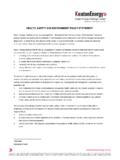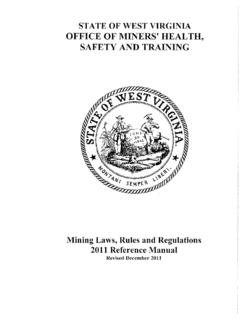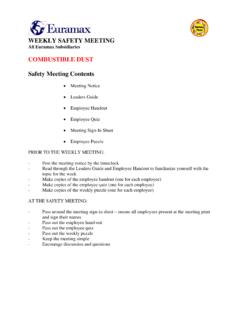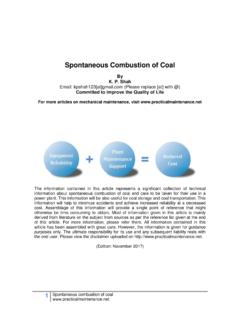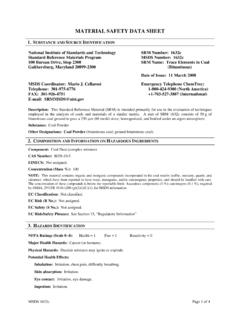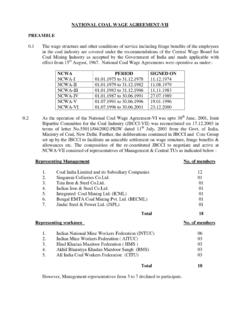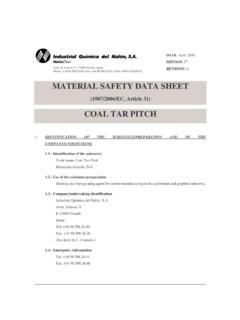Transcription of Coal Silo-Bunker Firefighting Procedures
1 HAZARD CONTROL TECHNOLOGIES, INC. Coal Silo-Bunker Firefighting Procedures This article was written in the May, 2012 edition of Coal People magazine and reviews the basic Procedures for locating and mitigating coal hot spots in bunkers and silos. Submitted to: Hazard Control Technologies, Inc. 150 Walter Way Fayetteville, GA 30214 Written by: Justin Clift Manager HCT Industrial May, 2012 HAZARD CONTROL TECHNOLOGIES, INC. Training for the local Fire Department on Piercing Rod Operations 50 By Justin Clift Manager HCT Industrial Any facility that handles coal is certain to experience a fire from time to time. It's the nature of the beast and plants must employ the proper measures to prepare, prevent and protect their facilities. As a result, a majority of these incidents are extinguished quickly and safely. However, year after year we hear about a major fire or explosion in the coal industry. The reason these major incidents occur can often be traced back to a manageable list of oversights (see Fig.)
2 1 ). A majority of these incidents are 100 percent preventable when utilizing the proper fire prevention, detection and suppression Procedures (see Fig. 2). Unfortunately, some facilities don't have adequate Procedures in place or in extreme cases, they have no Procedures at all. Furthermore, if these Procedures are not reviewed, revised and practiced annually, these plants are bound to make mistakes. A mistake while responding to a fire in a combustible dust environment can quickly lead to a flash fire or an explosion. Without a properly planned course of action, such facilities will jeopardize the health and safety of plant personnel and will fail to meet their goals. The following recommendations are based off HCT Emergency Response Team's ex-perience In combating stubborn hot spots in bulk storage. It's of the utmost impor-tance that each facility uses this procedure only as a guide to help them create a site-specific standard to follow in the event of a Bunker/Silo fire based on thei r design, detection methods, response capabilities and training.
3 The actions taken during the initial response period are crucial. If these Procedures are not strictly adhered to dur-ing the initial response period the probability of an explosion Is increased. Any extin-guishing efforts not discussed in this procedure may result in an unstable explosive hazard that can further jeopardize the health and safety of responding personnel. Coal People Magazine Fig. 1: Conduct a Thermal Scan to Assess the Hot Spot's size and location. Top Reason Major Fires and Dust Explosions Occur in the Power Industry Failure to respect potential hazards Failure to address near miss warning events - puffs Failure to maintain safety systems Lack of maintenance of production systems Lack of housekeeping Procedures Human error through complacency Poor hazard training programs Lack of proper engineering and design Lack of technical expertise Failure to comply with NFPA standards Lack of documentation, hazard analysis or review of design modifications lack of preparedness Lack of Procedures or training for abnormal operations Failure to plan for emergency response Failure to prepare community for emergencies (Local Fire Department) Younger inexperienced workers, replacing veterans MAY IV -Sa -1 -' '.
4 128 OFLIR . II J.. i i~~ .. ' . *', ;, - i ' I j i Fig. 2:Thermal Imaging Cameras can provide responders with a clear picture of a hot spot. Preventing Coal Fires Keep it on the Belt -Transfer Point Control Keep it Clean - Commitment to Housekeeping Keep it Fresh -Coal Pile Management Keep it Moving -Silo Management Keep it in Check - Monitoring Keep it Understood-Training Keep it Important- Cultural Change Give it Respect - Hazard Awareness Addressing Fires in Bulk Storage A deep-seated hot spot in bulk storage can be very difficult to extinguish. However; with the proper training and equipment these fires can safely and effectively be extinguished without incident. Hazard Control Technologies' (HCT) Emergency Response Team has found the following Procedures to be the most effective at dealing with these fires. Earlier detection is key when combating a silo/bunker fire. Fixed CO monitoring equipment has been proven to be the most effective tool in detecting the early signs of combustion.
5 When this equipment is fine tuned for your facility it will notify the control room when the CO levels reach alarm level 1. Since every plant varies in design and ventilation the alarm levels must be customized to suit each plant. Once a hot spot is detected or suspected, the first step is to do nothing until a complete assessment is performed. The assessment provides responders with a better understanding of the hot spot (size, location, temperature, depth and stage of spontaneous combustion). Investigate the report of a fire immediately. Once a fire is confirmed, you must stop all coal moving activities and verify the coal feeder inlet gate is 100 percent closed. Perform a heat survey of the fire area with laser thermometer or thermal imaging camera to show fire location and Intensity. Use of a laser pyrometer or thermal imaging camera will greatly improve the ability to quickly locate the seat of the fire and identify where the smoldering coal exists In a large bunker or coal feeder body.
6 Map the coal bunker and record temperatures to determine the location and intensity of the smoldering coal and to track the progress in extinguishing the fire. Once the location and area of the fire have been determined, a pre-job briefing will be held with all involved personnel. Conduct regular temperature monitoring until the fire is extinguished. Immediate response is required when the odor of burning coal or other evidence of a coal fire inside a silo is detected. Delay in taking action allows the rate of burning to increase and requires additional effort rontmued on page 54 Plant specific training on silo fires should be conducted annually. 51 nrenahtfna contfnaed to control or suppress the fire later on. Upon detection, an action plan must be developed and implemented. However, following actions should be avoided: DO NOT attempt smothering the fire with a layer of fresh coal. DO NOT run burning PRB coal through the feeders and mills. Doing so places the plant, equipment and employees In jeopardy due to the very high possibility of creating an explosion within the silo, feeder or mill.
7 DO NOT attempt to extinguish the hot spot with plain water, Class A or Class 8 foam. Plain water will not penetrate the coal or the burning hot spot. In addition, plain water could erode at foundation of the hot spot causing it to collapses. Foams will not penetrate the coal and the blanket they create will retain the heat and combustible vapors creating an environment for a hybrid vapor/dust explosion. DO NOT attempt using lnerting or Dry Ice. Neither method has proven to be successful in extinguishing deep-seated hot spots. lnerting can be used as a method to slow the development of a hot spot while emergency response teams are organized. Please note: Once lnerting has stopped due to depleted supply or a piercing rod attack, the hot spot will increase in temperature. When a fire is detected in a location or piece of equipment, all coal moving activities In and out of the affected location or equipment must be stopped. Dust collectors, belts, and other equipment that service the affected location or equipment or may create dust in the area must be shut down.
8 This is to minimize the chance of a fire or explosion occurring during fire suppression. Lock-Out-Tag-Out (LOTO) Procedures shall be followed as required. Coal bunker, coal silo, and coal feeder fires shall be extinguished using an approximate 1 percent or greater concentration of F-500 encapsulator agent and a Piercing Rod Kit. This method and concentration -are recommended In the PRB Coal Users Group Best Guidelines & Practices for Bunker & Silo Fires. The second step is to perform a wash down to remove combustible dust 54 Conduct a Washdown prior to attacking a silo lire to eliminate fugitive dust deposits. deposits on elevated surfaces above the silo or bunker. If dealing with a deep-seated hot spot, a wash down should be performed within the silo or bunker to remove any dust deposits on the 1-beams and silo/bunker walls. The goal is to encapsulate both the airborne dust particles and the by-products of combustion. Begin gravity or forced ventilation of the tripper deck if possible.
9 Open any overhead hatches or doors leading to the exterior of the plant. Do not open fire doors to the plant interior. Once the fire is attacked, smoke and steam will escape from the silo and will need to be ventilated to the exterior. Use of the silo dust collector during the fire may cause a fire or explosion in the dust collector. The dust collector can also act as a draft inducer, pulling air up through the bottom of the silo, thus accelerating the fire. Smoke and CO inside the silo can be reduced by fogging the headspace with an encapsulating agent (F-500) through a distributor nozzle. The agent will act as a scrubber and increase visibility and encapsulate CO gas. This is a recommended practice when dealing with a deep-seated hot spot. However, if experiencing a near-surface hot spot such activities may result in additional oxidation and a change in airflow may disrupt dust particles. Once the hazards of a secondary combustible dust explosion have been eliminated the responders can begin attacking the hot spot with a specially designed piercing rod and the Micelle Encapsulating Agent, F-500.
10 Micelle Encapsulating Agents have been found to be the most effective at extinguishing deep-seated hot spots due to their ability to encapsulate the fuel, penetrate the material and rapidly cool the hot spot. A surround and cooling approach is used as the piercing rod slowly advances towards the hot spot 5 feet at a time. After extinguishment, the final step is to monitor the hot spot until all the material has been removed from the silo or bunker. Never assume the fire has been extinguished until it has been confirmed with thermal imaging and CO monitors. Never rush into a response without a complete assessment. Each facility should create and strictly adhere to their plant specific Standard Operating Guidelines (SOG's) during an incident. These SOG's must be updated, reviewed and revised annually. It's also important to work with your responding Fire Departments and educate them on the hazards of combustible dust and silo Firefighting . With the appropriate Procedures and training plant's can meet their goal of establishing a safe practice that is consistently, efficiently and effectively used to control and extinguish fires in coal bunkers, coal silos, coal hoppers, and coal feeders.


